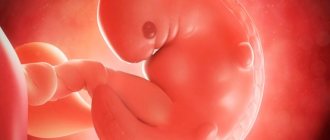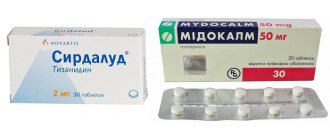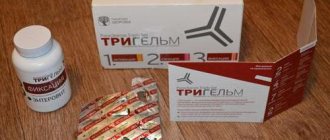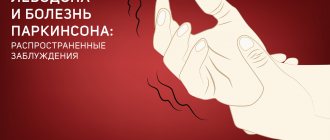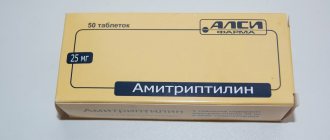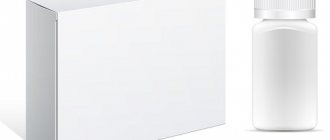Indications for use of Aminazin
The drug Aminazin is intended for treatment in the field of psychiatry:
- psychomotor agitation;
- acute delirious states;
- hypomanic/manic agitation in manic-depressive psychosis;
- chronic psychosis;
- mental illnesses of various origins, accompanied by insomnia, fear, agitation, anxiety;
- psychopathy;
- alcoholic psychosis;
- “uncontrollable” vomiting;
- nausea;
- persistent hiccups.
Aminazine is also used for persistent pain (increased action of analgesics), diseases accompanied by increased muscle tone, potentiation of general anesthesia, premedication, acute intermittent porphyria, and itchy dermatoses.
Methods of using Aminazin
The dosage of the drug is prescribed by the doctor individually to each patient. If the product is in the form of tablets or dragees, then adults are recommended to take 10-100 mg at a time, with a daily dosage of 25 to 600 mg.
For children (1-5 years old), Aminazine is indicated in a volume of 500 mcg per kilogram of body weight every 4-6 hours, for children over 5 years old - a third or half of the adult dose.
When using the drug in injection form, the initial dose for adults is 25-50 mg. Intramuscular or intravenous administration to children over 1 year of age implies 250-300 mcg per kilogram of weight per injection.
Contraindications of Aminazine
The antipsychotic drug is not recommended for use by persons with increased sensitivity (of an individual nature) to chlorpromazine or the auxiliary components of the drug.
You should also not use Aminazine if:
- severe cardiovascular diseases;
- old age;
- comatose states of any etiology;
- Reye's syndrome;
- inhibition of central nervous system function (pronounced);
- childhood (less than 6 months);
- traumatic brain injury;
- chronic diseases accompanied by breathing problems (especially in children);
- progressive systemic diseases of the spinal cord/brain;
- myxedema;
- pregnancy;
- lactation period;
- duodenal/stomach ulcer (internal administration, period of exacerbation);
- epilepsy;
- liver damage (cirrhosis, hepatitis, etc.).
Acute use of Aminazine is indicated for patients with Parkinson's disease, alcoholism, diseases accompanied by an increased risk of thromboembolic complications, hematopoietic disorders, renal/liver failure, breast cancer, prostate hyperplasia with clinical symptoms, angle-closure glaucoma, vomiting, cachexia.
Aminazine analogs without prescriptions
Drug interactions
With the simultaneous use of drugs that have a depressant effect on the central nervous system, ethanol, ethanol-containing drugs, it is possible to increase the depressant effect on the central nervous system, as well as respiratory depression.
With the simultaneous use of tricyclic antidepressants, maprotiline, MAO inhibitors, the risk of developing NMS may increase. When used simultaneously with anticonvulsants, the threshold for convulsive readiness may be reduced; with drugs for the treatment of hyperthyroidism - increased risk of developing agranulocytosis; with drugs that cause extrapyramidal reactions - an increase in the frequency and severity of extrapyramidal disorders is possible; with drugs that cause arterial hypotension - an additive effect on blood pressure is possible, which leads to severe arterial hypotension and increased orthostatic hypotension. When used concomitantly with amphetamines, antagonistic interactions are possible; with anticholinergic drugs - increased anticholinergic effect; with anticholinesterase drugs - muscle weakness, worsening myasthenia gravis. When used simultaneously with antacids containing aluminum and magnesium hydroxide, the concentration of chlorpromazine in the blood plasma decreases due to impaired absorption from the gastrointestinal tract. When used concomitantly, barbiturates enhance the metabolism of chlorpromazine, inducing microsomal liver enzymes and thereby reducing its concentration in the blood plasma. With the simultaneous use of hormonal contraceptives for oral administration, a case of increased concentrations of chlorpromazine in the blood plasma has been described. When used simultaneously with epinephrine, it is possible to “pervert” the pressor effect of epinephrine, as a result of which only stimulation of β-adrenergic receptors occurs and severe hypotension and tachycardia occur.
When used simultaneously with amitriptyline, the risk of developing tardive dyskinesia increases. Cases of the development of paralytic ileus have been described. When used concomitantly, chlorpromazine may reduce or even completely inhibit the antihypertensive effects of guanethidine, although some patients may experience the hypotensive effects of chlorpromazine. When used simultaneously with diazoxide, severe hyperglycemia is possible; with doxepin - potentiation of hyperpyrexia; with zolpidem - the sedative effect is significantly enhanced; with zopiclone - increased sedative effect is possible; with imipramine - the concentration of imipramine in the blood plasma increases. When used concomitantly, chlorpromazine suppresses the effects of levodopa due to blockade of dopamine receptors in the central nervous system. Extrapyramidal symptoms may increase.
When used simultaneously with lithium carbonate, severe extrapyramidal symptoms and neurotoxic effects are possible; with morphine - myoclonus may develop. With simultaneous use of nortriptyline in patients with schizophrenia, a worsening of the clinical condition may occur, despite increased levels of chlorpromazine in the blood plasma. Cases of the development of paralytic ileus have been described. With simultaneous use with piperazine, a case of seizures has been described; with propranolol - increased plasma concentrations of propranolol and chlorpromazine; with trazodone - arterial hypotension is possible; with trihexyphenidyl - there are reports of the development of paralytic ileus; with trifluoperazine - cases of severe hyperpyrexia have been described; with phenytoin - an increase or decrease in the concentration of phenytoin in the blood plasma is possible.
When used simultaneously with fluoxetine, the risk of developing extrapyramidal symptoms increases; with chloroquine, sulfadoxine/pyrimethamine, the concentration of chlorpromazine in the blood plasma increases with the risk of developing the toxic effect of chlorpromazine. With simultaneous use of cisapride, the QT interval on the ECG is additively prolonged. When used simultaneously with cimetidine, a decrease in the concentration of chlorpromazine in the blood plasma is possible. There is also evidence to suggest an increase in the concentration of chlorpromazine in the blood plasma. With simultaneous use of ephedrine, the vasoconstrictor effect of ephedrine may be weakened.
Side effects of Aminazine
Aminazine, as an antipsychotic drug, can cause the following side symptoms at the beginning of therapy:
- in the nervous system (peripheral/central) – dry mouth, dizziness, drowsiness, sleep disorder;
- in the digestive system – constipation, loss of appetite;
- in the cardiovascular system - tachycardia, sudden decrease in blood pressure;
- in the urinary system - urinary retention;
- in the reproductive system – frigidity, decreased potency;
- in the visual system - accommodation paresis;
- reactions of an allergic nature - angioedema (extremities, face), photosensitivity;
- other side effects - orthostatic hypotension (moderate).
With long-term use of Aminazine (at high dosage):
in the nervous system (peripheral/central) - extrapyramidal disorders, phenomena of delayed reaction to external stimuli, mental indifference, neuroleptic depression and other mental changes, convulsions (isolated cases);
- in the digestive system - cholestatic jaundice, vomiting, nausea, diarrhea;
- in the cardiovascular system - heart rhythm disturbances;
- in the visual system – clouding of the cornea/lens;
- skin reactions - skin pigmentation, tissue irritation, phlebitis (with intravenous administration), infiltrates;
- other manifestations - gynecomastia, suppression of bone marrow hematopoiesis, amenorrhea, hypercoagulation, hyperprolactinemia, galactorrhea, oliguria, neuroleptic malignant syndrome (isolated cases).
Patients who have used the antipsychotic leave good reviews of Aminazine. The effectiveness of the drug in the treatment of mental illnesses is especially noted.
Did the drug help you?
Helped
Didn't help
Total votes: 4
First vote: 11/21/2013
Last vote: 06/04/2015
If you have experience using this drug, please describe it in the reviews section about Aminazine - with this you can help many of our readers who are just planning to use it.
If you have the official instructions for Aminazin, then we will be grateful if you upload a scan of it to our website (using the button below) - it may also be useful to our readers.
Remember that this material is only a brief description of Aminazine in free presentation. Consultation with a doctor before taking it is required. Do not self-medicate under any circumstances - this can only harm yourself. Good health to you!
Instructions for use AMINAZIN
With the simultaneous use of Aminazin® with other drugs that have a depressant effect on the central nervous system (general anesthesia, narcotic analgesics, ethanol (alcohol) and drugs containing it, barbiturates, tranquilizers, etc.), increased depression of the central nervous system, as well as respiratory depression, is possible; prolonged combination with analgesics and antipyretics is undesirable - the development of hyperthermia is possible; with tricyclic antidepressants, maprotiline or MAO inhibitors - increased risk of developing neuroleptic malignant syndrome; with anticonvulsants - the seizure threshold may be lowered; with drugs for the treatment of hyperthyroidism - the risk of developing agranulocytosis increases; with other drugs that cause extrapyramidal reactions - an increase in the frequency and severity of extrapyramidal disorders is possible; with antihypertensive drugs - severe orthostatic hypotension is possible; with ephedrine - the vasoconstrictor effect of ephedrine may be weakened.
When treating with Aminazine®, the administration of epinephrine (adrenaline) should be avoided, as the effect of epinephrine may be distorted, which can lead to a drop in blood pressure. The antiparkinsonian effect of levodopa is reduced due to blocking of dopamine receptors. Aminazine® can suppress the effect of amphetamines, clonidine, guanethidine.
Aminazine® enhances the anticholinergic effects of other drugs, while the antipsychotic effect of the antipsychotic may decrease.
When Aminazine® is used simultaneously with prochlorperazine, which is related in chemical structure, prolonged loss of consciousness may occur.
Antacids, antiparkinsonian drugs and lithium salts can reduce the absorption of chlorpromazine; in addition, combination with lithium drugs increases the risk of extrapyramidal complications.
Chlorpromazine may mask some manifestations of ototoxicity (tinnitus, dizziness) of drugs that have ototoxic effects (for example, antibiotics with ototoxic effects).
Other hepatotoxic drugs increase the risk of developing hepatotoxicity. Drugs that inhibit bone marrow hematopoiesis increase the risk of myelosuppression. Aminazine® is not recommended for use with drugs that can cause Torsadesde Pointes type arrhythmia:
- class Ia antiarrhythmic drugs (eg quinidine, hydroquinidine, disopyramide);
- class III antiarrhythmic drugs (eg, amiodarone, sotalol);
- some antipsychotic drugs (eg, thioridazine, levomepromazine, trifluoperazine, sulpiride, tiapride, pimozide, haloperidol, droperidol);
- other agents (eg, bepridil, cisapride, erythromycin IV, halofantrine, ketanserin, mizolastine, pentamidine, sparfloxacin, terfenadine, vincamine IV, moxifloxacin, spiramycin IV).
Hypokalemia (as a result of taking diuretics, laxatives, glucocorticoids, tetracosactide, IV administration of amphotericin), bradycardia (as a result of taking class Ia and III antiarrhythmic drugs, beta blockers, some calcium channel blockers, digitalis drugs, pilocarpine, anticholinesterase drugs) , congenital or acquired prolongation of the QT interval predisposes to the development of arrhythmias such as Torsades de Pointes.
When using Aminazine in high doses (more than 100 mg/day), an increase in blood glucose levels may occur as a result of a decrease in insulin release. It is necessary to adjust the dose of insulin and other hypoglycemic agents during treatment with antipsychotics and after stopping their use.
When taken simultaneously with beta blockers (bisoprolol, carvedilol, metoprolol, nebivolol), the risk of developing ventricular arrhythmia, including arrhythmia of the Torsades de Pointes type, increases. In addition, the risk of developing arterial hypotension, including orthostatic, increases. Clinical observation and ECG monitoring are necessary. The risk of orthostatic hypotension is also increased when taking Aminazine® simultaneously with antihypertensive drugs and nitrates.
Taking antacids and activated charcoal reduces the intestinal absorption of phenothiazine neuroleptics. It is necessary to maintain an interval of at least 2 hours between taking these medications.
Aminazine price, where to buy
A package of 10 ampoules of 2 ml 25 mg/ml costs approximately 60 rubles.
10 tablets of 25 mg cost about 150 rubles.
The price of Aminazin in tablets is approximately 70 rubles per package of 10 pieces of 100 mg.
- Online pharmacies in RussiaRussia
- Online pharmacies in UkraineUkraine
- Online pharmacies in KazakhstanKazakhstan
ZdravCity
- Aminazine tablets p.p.o. 100 mg 10 pcs. JSC Valenta Pharmaceuticals
- Aminazine solution for intravenous and intramuscular administration. 2.5% 2ml 10 pcs. JSC Novosibkhimpharm
Pharmacy Dialogue
- Aminazine (tab.p.pl/vol. 25 mg No. 10) Valenta Pharmaceuticals OJSC
- Aminazine (tab.p.pl/vol. 50 mg No. 10) Valenta Pharmaceuticals OJSC
show more
Pharmacy24
- Aminazine 2.5% 2 ml N10 injection solution PAT "Galichfarm", Ukraine
PaniPharmacy
- Aminazine ampoule Aminazine solution d/in. 2.5% amp. 2ml No. 10 Ukraine, Galichfarm JSC
- Aminazine tablet. p/o 0.1g No. 10 in pack.
- Aminazine ampoule Aminazine solution d/in. 2.5% amp. 2ml No. 10 Ukraine, Health of the people LLC
- Aminazine tablets Aminazine tablets. p/o 0.025g No. 20 Ukraine, Health LLC
- Aminazine tablets Aminazine tablets. p/o 0.1g No. 10 Ukraine, Health LLC
show more



